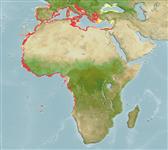Environment: milieu / climate zone / depth range / distribution range
Ecologia
marinhas demersal; intervalo de profundidade 15 - 200 m (Ref. 5222), usually 15 - 50 m (Ref. 2683). Subtropical; 43°N - 16°S, 20°W - 38°E (Ref. 5222)
Eastern Atlantic: Portugal to southern Angola; reports from islands require confirmation. Specimens from Madeira, Azores, Canary Islands, and Cape Verde have been examined by Heemstra (1991, Ref. 6512) and are identified to be Mycteroperca fusca. Replaced by Mycteroperca acutirostris in the western Atlantic.
Length at first maturity / Tamanho / Peso / Idade
Maturity: Lm 34.0, range 32 - 36 cm
Max length : 144 cm TL macho/indeterminado; (Ref. 40637); common length : 80.0 cm TL macho/indeterminado; (Ref. 2683); peso máx. Publicado: 49.7 kg (Ref. 40637)
Descrição breve
Chaves de identificação | Morfologia | Morfometria
Espinhos dorsais (total) : 11; Raios dorsais moles (total) : 15 - 17; Espinhos anais: 3; Raios anais moles: 11 - 12. Distinguished by the following characteristics: usually reddish brown, sometimes mottled with black or pale grey spots with black streak above maxilla; juveniles with black saddle blotch on peduncle; oblong body, compressed, depth contained 2.8-3.2 times in SL; head length 2.5-2.7 in SL; convex interorbital area; enlarged serrae at angle of preopercle, forming rounded lobe set off by the indentation immediately above; nostrils subequal in juveniles, posterior nostrils about twice that of anterior ones in adults (Ref. 89707).
Occurs over rocky and sandy bottoms; young individuals very common in mangrove-lined lagoons. Feeds on mollusks (presumably cephalopods) and small fishes (Ref. 89707). Marketed fresh.
Life cycle and mating behavior
Maturidade | Reprodução | Desova | Ovos | Fecundidade | Larvas
Heemstra, P.C. and J.E. Randall, 1993. FAO Species Catalogue. Vol. 16. Groupers of the world (family Serranidae, subfamily Epinephelinae). An annotated and illustrated catalogue of the grouper, rockcod, hind, coral grouper and lyretail species known to date. Rome: FAO. FAO Fish. Synop. 125(16):382 p. (Ref. 5222)
Categoria na Lista Vermelha da IUCN (Ref. 130435: Version 2024-1)
Ameaça para o homem
Harmless
Utilização humana
Pescarias: pouco comercial
Ferramentas
Relatórios especiais
Descarregue XML
Fontes da internet
Estimates based on models
Preferred temperature (Ref.
123201): 15.3 - 27.4, mean 19.4 °C (based on 296 cells).
Phylogenetic diversity index (Ref.
82804): PD
50 = 0.5000 [Uniqueness, from 0.5 = low to 2.0 = high].
Bayesian length-weight: a=0.01072 (0.00685 - 0.01675), b=3.01 (2.88 - 3.14), in cm total length, based on LWR estimates for this species & Genus-body shape (Ref.
93245).
Nível Trófico (Ref.
69278): 4.1 ±0.58 se; based on food items.
Generation time: 10.4 ( na - na) years. Estimated as median ln(3)/K based on 1
growth studies.
Resiliência (Ref.
120179): Muito baixo, tempo mínimo de duplicação da população maior que 14 anos (Preliminary K or Fecundity.).
Fishing Vulnerability (Ref.
59153): High to very high vulnerability (67 of 100).
Nutrients (Ref.
124155): Calcium = 34.6 [15.2, 67.1] mg/100g; Iron = 0.82 [0.44, 1.54] mg/100g; Protein = 18.6 [16.6, 20.2] %; Omega3 = 0.331 [0.208, 0.544] g/100g; Selenium = 40.9 [19.7, 83.1] μg/100g; VitaminA = 13.4 [4.2, 49.3] μg/100g; Zinc = 0.474 [0.334, 0.700] mg/100g (wet weight);
